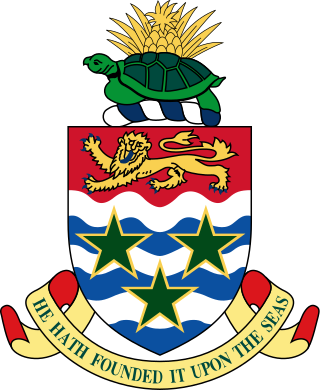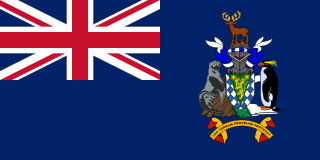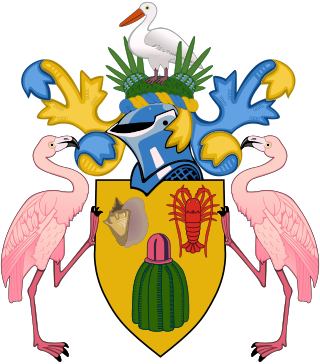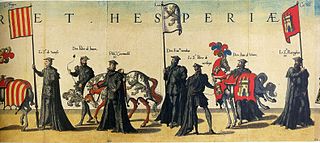
The coat of arms of Prince Edward Island, officially the King's Arms in Right of Prince Edward Island, are the coat of arms of Prince Edward Island, being the arms of King Charles III in right of the province. They were created when the shield and motto in the achievement were granted in 1905 by royal warrant from King Edward VII. The latest iteration was given by the Canadian Heraldic Authority in 2002.

The coat of arms of Saskatchewan, officially known as His Majesty's Arms in right of Saskatchewan, is the heraldic symbol representing the Canadian province of Saskatchewan.

A saltire, also called Saint Andrew's Cross or the crux decussata, is a heraldic symbol in the form of a diagonal cross. The word comes from the Middle French sautoir, Medieval Latin saltatoria ("stirrup").

The coat of arms of Quebec was adopted by order-in-council of the Government of Quebec on 9 December 1939, replacing the arms assigned by royal warrant of Queen Victoria on 26 May 1868.

The coat of arms of England is the coat of arms historically used as arms of dominion by the monarchs of the Kingdom of England, and now used to symbolise England generally. The arms were adopted c.1200 by the Plantagenet kings and continued to be used by successive English and British monarchs; they are currently quartered with the arms of Scotland and Ireland in the coat of arms of the United Kingdom. Historically they were also quartered with the arms of France, representing the English claim to the French throne, and Hanover.

The coat of arms of Belgium bears a lion or, known as Leo Belgicus, as its charge. This is in accordance with article 193 of the Belgian Constitution: The Belgian nation takes red, yellow and black as colours, and as state coat of arms the Belgian lion with the motto UNITY MAKES STRENGTH. A royal decree of 17 March 1837 determines the achievement to be used in the greater and the lesser version, respectively.

The flag of Jersey is composed of a red saltire on a white field. In the upper quadrant the badge of Jersey surmounted by a yellow "Plantagenet crown". The flag was adopted by the States of Jersey on 12 June 1979, proclaimed by Queen Elizabeth II on 10 December 1980 and first officially hoisted on 7 April 1981.

The coat of arms of theCayman Islands was approved by the Legislative Assembly in 1957, and public input was sought on its design. The Royal Warrant assigning "Armorial Ensigns for the Cayman Islands" was approved by Her Majesty's command on 14 May 1958.

The coat of arms of Newfoundland and Labrador was originally granted by Garter King of Arms, during the reign of King Charles I, on 1 January 1637/8.
In heraldry, an ordinary is one of the two main types of charges, beside the mobile charges. An ordinary is a simple geometrical figure, bounded by straight lines and running from side to side or top to bottom of the shield. There are also some geometric charges known as subordinaries, which have been given lesser status by some heraldic writers, though most have been in use as long as the traditional ordinaries. Diminutives of ordinaries and some subordinaries are charges of the same shape, though thinner. Most of the ordinaries are theoretically said to occupy one-third of the shield; but this is rarely observed in practice, except when the ordinary is the only charge.

The coat of arms of Zimbabwe was adopted on 21 September 1981, one year and five months after the national flag was adopted. Previously the coat of arms of Zimbabwe was identical to the former coat of arms of Rhodesia.

The Royal Badge of Wales was approved in May 2008. It is based on the arms borne by the 13th-century Welsh prince Llywelyn ab Iorwerth, with the addition of St Edward's Crown atop a continuous scroll which, together with a wreath consisting of the plant emblems of the four countries of the United Kingdom, surrounds the shield. The motto which appears on the scroll, PLEIDIOL WYF I'M GWLAD, is taken from the national anthem of Wales; it was also an element of the Welsh designs for £1 coins minted from 1985 until 2000. The badge formerly appeared on the covers of Assembly Measures; since the 2011 referendum, it now appears on the cover of Acts passed by the Senedd and its escutcheon, ribbon and motto are depicted on the Welsh Seal.

The flag of South Georgia and the South Sandwich Islands was granted on 3 October 1985, when the Territory was created. Previously the Territory was a part of the former Falkland Islands Dependencies and used the same flag as the Falklands Islands.

The coat of arms of Denmark has a lesser and a greater version.

The coat of arms of the British Virgin Islands consists of a green escutcheon (shield) charged with a woman in a white dress and gold-coloured sandals, holding a lit golden oil lamp and surrounded by eleven other golden lamps. Adopted shortly after the islands became a Crown colony, it has been the coat of arms of the British Virgin Islands since 1960. The escutcheon dates from the early 19th century and is featured on the flag of the territory. The woman and the lamps represent Saint Ursula and her companions, the namesake of the islands.

The coat of arms of the Turks and Caicos Islands consists of a gold-coloured escutcheon (shield) charged with a conch shell, lobster and a cactus, supported by two flamingos, and topped with a pelican in the crest. Adopted three years after the islands became a Crown colony, it has been the coat of arms of the Turks and Caicos Islands since 1965. The escutcheon is featured on the flag of the territory. The previous badge featured two mounds of salt in front of a ship, with doors added to the mounds after they were reportedly mistaken for igloos.

The lion is a common charge in heraldry. It traditionally symbolises courage, nobility, royalty, strength, stateliness and valour, because historically the lion has been regarded as the "king of beasts". The lion also carries Judeo-Christian symbolism. The Lion of Judah stands in the coat of arms of Jerusalem. Similar-looking lions can be found elsewhere, such as in the coat of arms of the Swedish royal House of Bjälbo, from there in turn derived into the coat of arms of Finland, formerly belonging to Sweden.

The flag of Sark consists of a white background with a red St. George's cross and a red canton containing the two yellow lions from the flag of Normandy. This version of the flag was officially granted in 2020.
Coats of arms and seals of the County and Duchy of Cornwall, the Diocese of Truro, and of Cornish boroughs and towns.

The first instance of a figure of the lion as symbol of the Kingdom of León is found in minted coins of Alfonso VII, called the Emperor (1126–1157). Until then, the cross had a preponderant position on documents and coins of Leonese monarchs since that reign the cross was gradually displaced by the lion. The Spanish historian and heraldist Martín de Riquer explained that the lion was already used as heraldic emblem in 1148. At the end of the reign of Alfonso VII, the figure of this animal began to appear on royal documents as personal device of the monarch and became pervasive during reigns of Ferdinand II (1157-1188) and Alfonso IX (1188-1230).


















